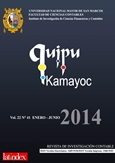TOWARDS A STANDARD SPECIFIC ENVIRONMENTAL ACCOUNTING: RECOGNITION AND COMPREHENSIVE MEASUREMENT INFORMATION
DOI:
https://doi.org/10.15381/quipu.v22i41.10064Keywords:
Environmental accounting standard, conceptual framework, measurement recognition, traditional accountingAbstract
The issue of environmental impact in the world, let’s admit the presence of the emergence of a new accoun-ting business and financial discipline, with changes in the conceptual framework and the specific rules that add value to traditional accounting information. This would involve the adoption of new measurement methods, estimates and conceptual update on assets, liabilities, expenses, costs and liabilities; with the particulars surrounding the “environment”, leading him to a more qualitative than quantitative analysis. A challenge for the accounting science and interference from other sciences, to provide more knowledge. There is no specific environmental accounting stan-dard before this vacuum, using certain existing rules are presenting a generic treatment for environmental situations such as: NIC 16, NIC 36, NIC 37 and NIC 38. The goal is to express the need to establish thefoundation for a conceptual framework and scope of the environmental standard, bases for recognition, measurement and disclosure, in order to achieve comprehensive accounting information. Currently, the issue is under investigation, which has a deductive descriptive methodological approach. In the end, we intend to present a structure of the foundations for an environmental framework.
Downloads
Downloads
Published
Issue
Section
License
Copyright (c) 2014 Elsa Esther Choy Zevallos

This work is licensed under a Creative Commons Attribution-NonCommercial-ShareAlike 4.0 International License.
AUTHORS RETAIN THEIR RIGHTS:
a. Authors retain their trade mark rights and patent, and also on any process or procedure described in the article.
b. Authors retain their right to share, copy, distribute, perform and publicly communicate their article (eg, to place their article in an institutional repository or publish it in a book), with an acknowledgment of its initial publication in Quipukamayoc .
c. Authors retain theirs right to make a subsequent publication of their work, to use the article or any part thereof (eg a compilation of his papers, lecture notes, thesis, or a book), always indicating the source of publication (the originator of the work, journal, volume, number and date).






